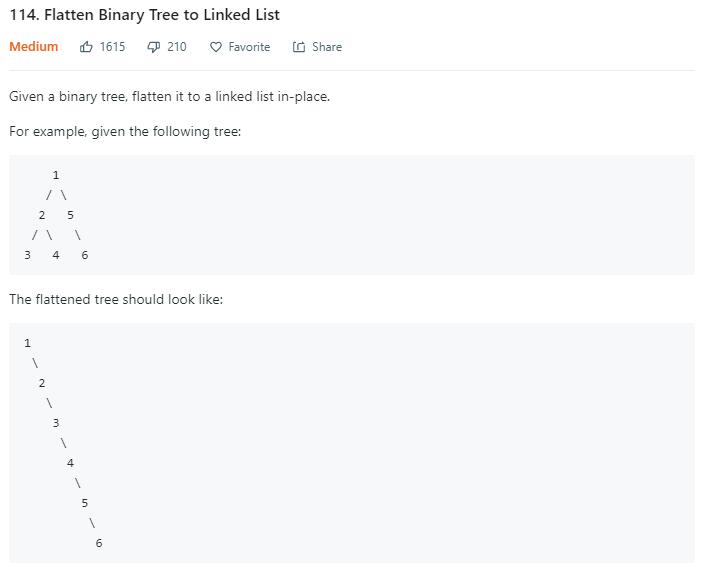LeetCode 力扣 114. 二叉树展开为链表
题目描述(中等难度)
把一个二叉树展开成一个链表,展开顺序如图所示。
解法一
可以发现展开的顺序其实就是二叉树的先序遍历。算法和 94 题 中序遍历的 Morris 算法有些神似,我们需要两步完成这道题。
- 将左子树插入到右子树的地方
- 将原来的右子树接到左子树的最右边节点
- 考虑新的右子树的根节点,一直重复上边的过程,直到新的右子树为 null
可以看图理解下这个过程。
1
/ \
2 5
/ \ \
3 4 6
//将 1 的左子树插入到右子树的地方
1
\
2 5
/ \ \
3 4 6
//将原来的右子树接到左子树的最右边节点
1
\
2
/ \
3 4
\
5
\
6
//将 2 的左子树插入到右子树的地方
1
\
2
\
3 4
\
5
\
6
//将原来的右子树接到左子树的最右边节点
1
\
2
\
3
\
4
\
5
\
6
......
代码的话也很好写,首先我们需要找出左子树最右边的节点以便把右子树接过来。
public void flatten(TreeNode root) {
while (root != null) {
//左子树为 null,直接考虑下一个节点
if (root.left == null) {
root = root.right;
} else {
// 找左子树最右边的节点
TreeNode pre = root.left;
while (pre.right != null) {
pre = pre.right;
}
//将原来的右子树接到左子树的最右边节点
pre.right = root.right;
// 将左子树插入到右子树的地方
root.right = root.left;
root.left = null;
// 考虑下一个节点
root = root.right;
}
}
}
解法二
题目中,要求说是in-place,之前一直以为这个意思就是要求空间复杂度是O(1)。偶然看见评论区 StefanPochmann 大神的解释。
也就是说in-place 的意思可能更多说的是直接在原来的节点上改变指向,空间复杂度并没有要求。所以这道题也可以用递归解一下,参考 这里 。
1
/ \
2 5
/ \ \
3 4 6
利用递归的话,可能比解法一难理解一些。
题目其实就是将二叉树通过右指针,组成一个链表。
1 -> 2 -> 3 -> 4 -> 5 -> 6
我们知道题目给定的遍历顺序其实就是先序遍历的顺序,所以我们能不能利用先序遍历的代码,每遍历一个节点,就将上一个节点的右指针更新为当前节点。
先序遍历的顺序是1 2 3 4 5 6。
遍历到2,把1的右指针指向2。1 -> 2 3 4 5 6。
遍历到3,把2的右指针指向3。1 -> 2 -> 3 4 5 6。
… …
一直进行下去似乎就解决了这个问题。但现实是残酷的,原因就是我们把1的右指针指向2,那么1的原本的右孩子就丢失了,也就是5 就找不到了。
解决方法的话,我们可以逆过来进行。
我们依次遍历6 5 4 3 2 1,然后每遍历一个节点就将当前节点的右指针更新为上一个节点。
遍历到5,把5的右指针指向6。6 <- 5 4 3 2 1。
遍历到4,把4的右指针指向5。6 <- 5 <- 4 3 2 1。
… …
1
/ \
2 5
/ \ \
3 4 6
这样就不会有丢失孩子的问题了,因为更新当前的右指针的时候,当前节点的右孩子已经访问过了。
而6 5 4 3 2 1的遍历顺序其实变形的后序遍历,遍历顺序是右子树->左子树->根节点。
先回想一下变形的后序遍历的代码
public void PrintBinaryTreeBacRecur(TreeNode<T> root){
if (root == null)
return;
PrintBinaryTreeBacRecur(root.right);
PrintBinaryTreeBacRecur(root.left);
System.out.print(root.data);
}
这里的话,我们不再是打印根节点,而是利用一个全局变量pre,更新当前根节点的右指针为pre,左指针为null。
private TreeNode pre = null;
public void flatten(TreeNode root) {
if (root == null)
return;
flatten(root.right);
flatten(root.left);
root.right = pre;
root.left = null;
pre = root;
}
相应的左孩子也要置为null,同样的也不用担心左孩子丢失,因为是后序遍历,左孩子已经遍历过了。和 112 题 一样,都巧妙的利用了后序遍历。
既然后序遍历这么有用,利用 112 题 介绍的后序遍历的迭代方法,把这道题也改一下吧。
public void flatten(TreeNode root) {
Stack<TreeNode> toVisit = new Stack<>();
TreeNode cur = root;
TreeNode pre = null;
while (cur != null || !toVisit.isEmpty()) {
while (cur != null) {
toVisit.push(cur); // 添加根节点
cur = cur.right; // 递归添加右节点
}
cur = toVisit.peek(); // 已经访问到最右的节点了
// 在不存在左节点或者右节点已经访问过的情况下,访问根节点
if (cur.left == null || cur.left == pre) {
toVisit.pop();
/**************修改的地方***************/
cur.right = pre;
cur.left = null;
/*************************************/
pre = cur;
cur = null;
} else {
cur = cur.left; // 左节点还没有访问过就先访问左节点
}
}
}
解法三
解法二中提到如果用先序遍历的话,会丢失掉右孩子,除了用后序遍历,还有没有其他的方法避免这个问题。在Discuss又发现了一种解法,参考 这里。
为了更好的控制算法,所以我们用先序遍历迭代的形式,正常的先序遍历代码如下,
public static void preOrderStack(TreeNode root) {
if (root == null) {
return;
}
Stack<TreeNode> s = new Stack<TreeNode>();
while (root != null || !s.isEmpty()) {
while (root != null) {
System.out.println(root.val);
s.push(root);
root = root.left;
}
root = s.pop();
root = root.right;
}
}
还有一种特殊的先序遍历,提前将右孩子保存到栈中,我们利用这种遍历方式就可以防止右孩子的丢失了。由于栈是先进后出,所以我们先将右节点入栈。
public static void preOrderStack(TreeNode root) {
if (root == null){
return;
}
Stack<TreeNode> s = new Stack<TreeNode>();
s.push(root);
while (!s.isEmpty()) {
TreeNode temp = s.pop();
System.out.println(temp.val);
if (temp.right != null){
s.push(temp.right);
}
if (temp.left != null){
s.push(temp.left);
}
}
}
之前我们的思路如下:
题目其实就是将二叉树通过右指针,组成一个链表。
1 -> 2 -> 3 -> 4 -> 5 -> 6
我们知道题目给定的遍历顺序其实就是先序遍历的顺序,所以我们可以利用先序遍历的代码,每遍历一个节点,就将上一个节点的右指针更新为当前节点。
先序遍历的顺序是1 2 3 4 5 6。
遍历到2,把1的右指针指向2。1 -> 2 3 4 5 6。
遍历到3,把2的右指针指向3。1 -> 2 -> 3 4 5 6。
… …
因为我们用栈保存了右孩子,所以不需要担心右孩子丢失了。用一个pre变量保存上次遍历的节点。修改的代码如下:
public void flatten(TreeNode root) {
if (root == null){
return;
}
Stack<TreeNode> s = new Stack<TreeNode>();
s.push(root);
TreeNode pre = null;
while (!s.isEmpty()) {
TreeNode temp = s.pop();
/***********修改的地方*************/
if(pre!=null){
pre.right = temp;
pre.left = null;
}
/********************************/
if (temp.right != null){
s.push(temp.right);
}
if (temp.left != null){
s.push(temp.left);
}
/***********修改的地方*************/
pre = temp;
/********************************/
}
}
总
解法一和解法三可以看作自顶向下的解决问题,解法二可以看作自底向上。以前觉得后序遍历比较麻烦,没想到竟然连续遇到了后序遍历的应用。先序遍历的两种方式自己也是第一次意识到,之前都是用的第一种正常的方式。
更多详细通俗题解详见 leetcode.wang 。

